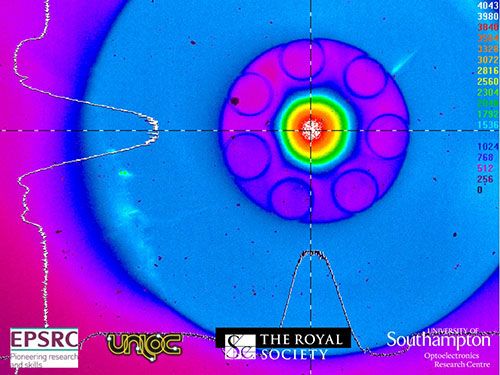
Beyond standard fibre – exploring the potential of hollow core fibre
31 March, 2017
UNLOC researchers have contributed to a new record data transmission – 6.8Tbit/s – in a type of fibre called antiresonant hollow core fibre.
The optical fibre currently deployed under our roads, across our oceans and in data centres all over the world is classed as standard fibre. UNLOC is collaborating with the Photonics Hyperhighway project based at the Optoelectronics Research Centre (ORC) at the University of Southampton to find out whether hollow core fibre could be the new norm.
In standard optical fibre, light pulses that carry data travel through a glass core. In contrast to standard fibre that guides light by total reflection, hollow core fibre guides light in an air core and comes in two fundamentally different guidance mechanisms.
The first type, known as hollow core photonic band gap fibre, uses an energy barrier to keep the light signal within the fibre and has been studied extensively. The other emerging type, hollow core antiresonant fibre, uses a reflective coating inside the core of the fibre to guide the light along the fibre. This is the type that UNLOC’s Dr Zhixin Liu and colleagues from UCL and Southampton are working with.
There are two main ways that hollow core fibre might be the preferred fibre of the future. First is that the light pulses can travel at full light speed, whereas the glass in standard fibre slows the light to about two thirds of light speed. This potentially allows for ultimately low latency transmission, i.e. faster data transfer. This is particularly important in applications like high-frequency trading, where the ability to make transactions faster than competitors can mean big returns.
The second potential benefit is the ability to carry higher power light signals than standard fibre. In standard fibre, the interaction between light signals and glass (known as fibre nonlinearity) limits the maximum transmission capacity that is physically possible. Hollow core fibre, however, can possibly overcome this limitation due to the lack of nonlinearity.
Yet the key potential advantage of hollow core fibre is its capability of very high transmission capacities, however there have been no prior high-speed data transmission studies in antiresonant hollow core fibre.
In the UNLOC-Hyperhighway collaboration, researchers from UCL and Southampton University worked together to demonstrate the potential of hollow core antiresonant fibre for data transmission. The team used advanced methods of encoding data in light signals with negligible penalty in terms of signal-to-noise-ratio and achieved the highest data rate ever transmitted through a hollow core antiresonant fibre - 6.8Tbit/s – 680 times higher capacity than state-of-the-art demonstrations to date. For the first time, they confirmed that hollow core fibre can handle high optical powers (up to 3W), showing no nonlinearity penalty that traditionally limits standard fibre.
These encouraging results make hollow core antiresonant fibre a very promising transmission medium for future low-delay, ultra-high capacity data communications.
